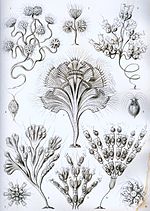Heliozoa, commonly known as sun-animalcules, are microbial eukaryotes (protists) with stiff arms (axopodia) radiating from their spherical bodies, which...
6 KB (505 words) - 16:56, 3 November 2024
rhizochromulinid algae, actinomonad heterotrophic flagellates and actinophryid heliozoa. Alternative classifications treat the dictyochophytes as heterokont algae...
6 KB (559 words) - 19:17, 24 October 2024
Actinophrys is a genus of heliozoa, amoeboid unicellular organisms with many axopodial filaments that radiate out of their cell. It contains one of the...
6 KB (443 words) - 15:10, 11 April 2024
The actinophryids are an order of heliozoa, a polyphyletic array of stramenopiles, having a close relationship with pedinellids and Ciliophrys. They are...
17 KB (1,856 words) - 14:54, 11 April 2024
proteromonad flagellates (all endobionts in other organisms); the actinophryid heliozoa, and oomycetes. The tripartite hairs characteristic of the group have been...
33 KB (3,303 words) - 12:05, 31 August 2024
ISBN 0-521-30419-9. Mikryukov, K.A. (2001). Heliozoa as a component of marine microbenthos: a study of Heliozoa of the White Sea. Ophelia 54: 51–73. Wikispecies...
13 KB (1,337 words) - 12:10, 5 November 2024
Cryptista and "N.N.", Haptista corresponds to the above phyla Haptophyta and Heliozoa): Molecular trees have had difficulty resolving relationships between the...
26 KB (2,441 words) - 01:22, 10 October 2024
it was found they have mitochondria with tubular cristae, as do other heliozoa, while in centrohelids the cristae are flat. Although this is no longer...
13 KB (1,154 words) - 18:42, 2 November 2024
Actinosphaerium is a genus of heliozoa, amoeboid unicellular organisms with many axopodial filaments that radiate out of their cell. It is classified within...
7 KB (606 words) - 15:11, 11 April 2024
most of the cell's energy. Some of this organization is found among the heliozoa, but those lack central capsules and only produce simple scales and spines...
28 KB (2,561 words) - 18:37, 13 September 2024










